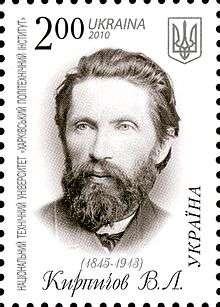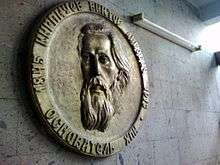Viktor Kirpichov
Viktor Lvovich Kirpichov (Ukrainian: Ві́ктор Льво́вич Кирпичо́в, Russian: Ви́ктор Льво́вич Кирпичё́в,8 October [O.S. 26 September] 1845, Saint Petersburg, Russian Empire – 20 October [O.S. 6 October] 1913, Saint Petersburg, Russian Empire) was a prominent Russian engineer, physicist, and educational organizer, known especially for his work on applied and structural mechanics as well as for establishing the foundations for technical education in the Russian Empire.

Early biography
Viktor Lvovich Kirpichov graduated from the Polotsk military school (1862) and St.Michael artillery school in Saint Petersburg (1863). In 1863–1870 he was in the faculty of Kronstadt military academy where he taught material science and mechanics. In 1873 he was a postdoc student of Gustav Kirchhoff in Germany. After that, until his move to Ukraine in 1885, he was a professor at Saint Petersburg Technological Institute. In 1882, he was responsible for investigation of the Borki train disaster.

University founder in Ukraine
Viktor Kirpichov is the most widely known in Ukraine as the founder and first rector of two prominent technical universities in this country (then a part of the Russian Empire):
- Kharkiv Polytechnic Institute (a rector in 1885–1898)
- Kiev Polytechnic Institute (a rector in 1898–1902)
Founding these universities was a part of wide program of technical education in the Russian Empire set up by Dmitriy Mendeleev. Professor Kirpichov was a prominent provider of this program serving as a member of both a Working Committee for elaborating the project of common plan for professional education in the Russian Empire (1884), and the Committee for higher education (1897).
USA visit
In 1893, Kirpichov was invited to USA, where he was an expert at the Chicago world's fair and visited numerous engineering facilities.
Later years
During his last years, Professor Kirpichov returned to Saint Petersburg, where he taught applied mechanics in Saint Petersburg Technological Institute. He remained a Honored Professor of Kiev Polytechnic Institute until the end of his life.
He was buried at the Lutheran Volkovo Cemetery, Saint Petersburg.